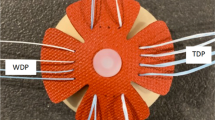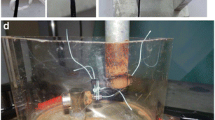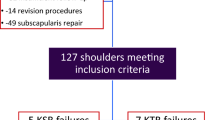Abstract
Purpose
Evaluate the biomechanical behavior of four variants of the transosseous-equivalent/suture bridge (TOE/SB) repair.
Methods
Four suture bridge (SB) constructs were created using 24 sheep infraspinatus tendon-humerus constructs (n = 6 per technique). The groups were (1) Knotted Standard Suture Bridge (Standard SB)—suture bridge with two medial mattress stitches, (2) Knotted Double Suture Bridge (Double SB)—four medial mattress stitches, (3) Untied Suture Bridge with Medial FT Anchors (Untied SB with FT)—two medial mattress stitches without knots, and (4) Untied Suture Bridge with PushLocks (Untied SB with Pushlocks)—two medial mattress stitches without knots. The contact area footprint was measured with an electronic pressure film prior to dynamic mechanical testing for gapping and testing to failure.
Results
The Double SB produced the greatest contact area footprint compared to the other techniques, which did not differ. The Double SB repair with a mean failure load of 456.9N was significantly stronger than the Untied SB with Pushlocks repair at 300N (P = 0.023), the standard SB repair at 295N (P = 0.019), and lastly the Untied SB with FT repair at 284N (P = 0.011). No differences were detected between the two mattress stitch standard SB repair with knots and the knotless two mattress stitch repairs (Untied SB with FT and Untied SB with Pushlocks). Gaps developed during cyclic loading in all repairs apart from the Double SB repair.
Conclusions
The transosseous-equivalent/suture bridge repair with 4 stitches tied in the medial row and maximal lateral suture strand utilization (Double SB) outperformed all other repairs in terms of failure load, tendon–bone contact, and gapping characteristics. The presence of knots in the medial row did not change tendon fixation with respect to failure load, contact area or gapping characteristics.





Similar content being viewed by others
References
Ahmad CS, Bell JE, ElAttrache NS (2007) Update on repair biomechanics for rotator cuff fixation. Tech Should Elb Surg 8:58–68
Bell DJ, Rooney J, Negrine JP, Vu DH, Walsh WR (2002) Biomechanical assessment of Weber B ankle fractures in a human cadaver model. Foot 12:77–82
Bishop J, Klepps S, Lo IK, Bird J, Gladstone JN, Flatow EL (2006) Cuff integrity after arthroscopic versus open rotator cuff repair: a prospective study. J Shoulder Elbow Surg 15:290–299
Boileau P, Brassart N, Watkinson DJ, Carles M, Hatzidakis AM, Krishnan SG (2005) Arthroscopic repair of full-thickness tears of the supraspinatus: does the tendon really heal? J Bone Joint Surg Am 87:1229–1240
Bolt P, Clerk AN, Luu HH, Kang Q, Kummer JL, Deng ZL, Olson K, Primus F, Montag AG, He TC, Haydon RC, Toolan BC (2007) BMP-14 gene therapy increases tendon tensile strength in a rat model of Achilles tendon injury. J Bone Joint Surg Am 89:1315–1320
Burkhart SS (2000) A stepwise approach to arthroscopic rotator cuff repair based on biomechanical principles. Arthroscopy 16:82–90
Busfield BT, Glousman RE, McGarry MH, Tibone JE, Lee TQ (2008) A biomechanical comparison of 2 technical variations of double-row rotator cuff fixation: the importance of medial row knots. Am J Sports Med 36:901–906
Christoforeti JJ, Krupp RJ, Singleton SB, Kissenberth MJ, Cook C, Hawkins RJ (2010) The effect of suture bridge double row fixation on rotator cuff tendon blood flow. In: 11th International congress of shoulder and elbow surgery 3rd international congress of shoulder and elbow therapists, Edinburgh, Scotland, p 51
Cole BJ, ElAttrache NS, Anbari A (2007) Arthroscopic rotator cuff repairs: an anatomic and biomechanical rationale for different suture-anchor repair configurations. Arthroscopy 23:662–669
Coleman SH, Fealy S, Ehteshami JR, MacGillivray JD, Altchek DW, Warren RF, Turner AS (2003) Chronic rotator cuff injury and repair model in sheep. J Bone Joint Surg Am 85-A:2391–2402
Demirhan M, Atalar AC, Kilicoglu O (2003) Primary fixation strength of rotator cuff repair techniques: a comparative study. Arthroscopy 19:572–576
LP Flurin PH, Gregory T (2007) Cuff integrity after arthroscopic rotator cuff repair; correlation with clinical results in 576 cases. Arthroscopy 23:340–346
Fuchs B, Gilbart MK, Hodler J, Gerber C (2006) Clinical and structural results of open repair of an isolated one-tendon tear of the rotator cuff. J Bone Joint Surg Am 88:309–316
Gerber C, Meyer DC, Schneeberger AG, Hoppeler H, von Rechenberg B (2004) Effect of tendon release and delayed repair on the structure of the muscles of the rotator cuff: an experimental study in sheep. J Bone Joint Surg Am 86-A:1973–1982
Gerber C, Schneeberger AG, Beck M, Schlegel U (1994) Mechanical strength of repairs of the rotator cuff. J Bone Joint Surg Br 76:371–380
Gerber C, Schneeberger AG, Perren SM, Nyffeler RW (1999) Experimental rotator cuff repair. A preliminary study. J Bone Joint Surg Am 81:1281–1290
Glaser DL, Sher JS, Ricchetti ET, Willims GR, Soslowsky LJ (2007) Anatomy, biomechanics, and pathophysiology of rotator cuff disease. In: Iannotti JP, Williams GR (eds) Disorders of the shoulder: diagnosis and management, vol 1, 2nd edn. Lippincott Williams wilkins, Philadelphia, PA, pp 3–38
Green A (2003) Chronic massive rotator cuff tears: evaluation and management. J Am Acad Orthop Surg 11:321–331
Harris ML, Morberg P, Bruce WJ, Walsh WR (1999) An improved method for measuring tibiofemoral contact areas in total knee arthroplasty: a comparison of K-scan sensor and Fuji film. J Biomech 32:951–958
Hoffmann A, Pelled G, Turgeman G, Eberle P, Zilberman Y, Shinar H, Keinan-Adamsky K, Winkel A, Shahab S, Navon G, Gross G, Gazit D (2006) Neotendon formation induced by manipulation of the Smad8 signalling pathway in mesenchymal stem cells. J Clin Invest 116:940–952
Hughes PJ, Evans RO, Miller B, Goldberg J, Sonnabend DH, Walsh WR (2005) Boundary conditions at the tendon-bone interface. Knee Surg Sports Traumatol Arthrosc 13:55–59
Jost B, Pfirrmann CW, Gerber C, Switzerland Z (2000) Clinical outcome after structural failure of rotator cuff repairs. J Bone Joint Surg Am 82:304–314
Juncosa-Melvin N, Boivin GP, Gooch C, Galloway MT, West JR, Dunn MG, Butler DL (2006) The effect of autologous mesenchymal stem cells on the biomechanics and histology of gel-collagen sponge constructs used for rabbit patellar tendon repair. Tissue Eng 12:369–379
Kim DH, Elattrache NS, Tibone JE, Jun BJ, DeLaMora SN, Kvitne RS, Lee TQ (2006) Biomechanical comparison of a single-row versus double-row suture anchor technique for rotator cuff repair. Am J Sports Med 34:407–414
Lafosse L, Brozska R, Toussaint B, Gobezie R (2007) The outcome and structural integrity of arthroscopic rotator cuff repair with use of the double-row suture anchor technique. J Bone Joint Surg Am 89:1533–1541
Lewis CW, Schlegel TF, Hawkins RJ, James SP, Turner AS (2001) The effect of immobilization on rotator cuff healing using modified Mason-Allen stitches: a biomechanical study in sheep. Biomed Sci Instrum 37:263–268
Lou J, Tu Y, Burns M, Silva MJ, Manske P (2001) BMP-12 gene transfer augmentation of lacerated tendon repair. J Orthop Res 19:1199–1202
Ma CB, Comerford L, Wilson J, Puttlitz CM (2006) Biomechanical evaluation of arthroscopic rotator cuff repairs: double-row compared with single-row fixation. J Bone Joint Surg Am 88:403–410
Meier SW, Meier JD (2006) The effect of double-row fixation on initial repair strength in rotator cuff repair: a biomechanical study. Arthroscopy 22:1168–1173
Meyer DC, Jacob HA, Nyffeler RW, Gerber C (2004) In vivo tendon force measurement of 2-week duration in sheep. J Biomech 37:135–140
Nicklin S, Waller C, Walker P, Chung WK, Walsh WR (2000) In vitro structural properties of braided tendon grafts. Am J Sports Med 28:790–793
Nightingale EJ, Walsh WR (2005) Radiofrequency energy effects on the mechanical properties of tendon and capsule. Arthroscopy 21:1479–1485
Park MC, Elattrache NS, Ahmad CS, Tibone JE (2006) “Transosseous-equivalent” rotator cuff repair technique. Arthroscopy 22:1360.e1–1360.e5
Park MC, Tibone JE, ElAttrache NS, Ahmad CS, Jun BJ, Lee TQ (2007) Part II: biomechanical assessment for a footprint-restoring transosseous-equivalent rotator cuff repair technique compared with a double-row repair technique. J Shoulder Elbow Surg 16:469–476
Pauly S, Kieser B, Schill A, Gerhardt C, Scheibel M (2010) Biomechanical comparison of 4 double-row suture-bridging rotator cuff repair techniques using different medial-row configurations. Arthroscopy 26:1281–1288
Rodeo SA, Kawamura S, Kim HJ, Dynybil C, Ying L (2006) Tendon healing in a bone tunnel differs at the tunnel entrance versus the tunnel exit: an effect of graft-tunnel motion? Am J Sports Med 34:1790–1800
Rodeo SA, Potter HG, Kawamura S, Turner AS, Kim HJ, Atkinson BL (2007) Biologic augmentation of rotator cuff tendon-healing with use of a mixture of osteoinductive growth factors. J Bone Joint Surg Am 89:2485–2497
Rossouw DJ, McElroy BJ, Amis AA, Emery RJ (1997) A biomechanical evaluation of suture anchors in repair of the rotator cuff. J Bone Joint Surg Br 79:458–461
Sano H, Wakabayashi I, Itoi E (2006) Stress distribution in the supraspinatus tendon with partial-thickness tears: an analysis using two-dimensional finite element model. J Shoulder Elbow Surg 15:100–105
Schneeberger AG, von Roll A, Kalberer F, Jacob HA, Gerber C (2002) Mechanical strength of arthroscopic rotator cuff repair techniques: an in vitro study. J Bone Joint Surg Am 84A:2152–2160
Smith CD, Alexander S, Hill AM, Huijsmans PE, Bull AM, Amis AA, De Beer JF, Wallace AL (2006) A biomechanical comparison of single and double-row fixation in arthroscopic rotator cuff repair. J Bone Joint Surg Am 88:2425–2431
Spang JT, Buchmann S, Brucker PU, Kouloumentas P, Obst T, Schroder M, Burgkart R, Imhoff AB (2009) A biomechanical comparison of 2 transosseous-equivalent double-row rotator cuff repair techniques using bioabsorbable anchors: cyclic loading and failure behavior. Arthroscopy 25:872–879
Wakabayashi I, Itoi E, Sano H, Shibuya Y, Sashi R, Minagawa H, Kobayashi M (2003) Mechanical environment of the supraspinatus tendon: a two-dimensional finite element model analysis. J Shoulder Elbow Surg 12:612–617
Wolf EM, Pennington WT, Agrawal V (2004) Arthroscopic rotator cuff repair: 4- to 10-year results. Arthroscopy 20:5–12
Zanetti M, Jost B, Hodler J, Gerber C (2000) MR imaging after rotator cuff repair: full-thickness defects and bursitis-like subacromial abnormalities in asymptomatic subjects. Skeletal Radiol 29:314–319
Author information
Authors and Affiliations
Corresponding author
Rights and permissions
About this article
Cite this article
Maguire, M., Goldberg, J., Bokor, D. et al. Biomechanical evaluation of four different transosseous-equivalent/suture bridge rotator cuff repairs. Knee Surg Sports Traumatol Arthrosc 19, 1582–1587 (2011). https://doi.org/10.1007/s00167-011-1436-x
Received:
Accepted:
Published:
Issue Date:
DOI: https://doi.org/10.1007/s00167-011-1436-x




